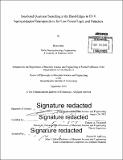Interband quantum tunneling at the band-edges in III-V semiconductor heterojunctions for low-power logic and detectors
Author(s)
Iutzi, Ryan (Ryan Michael)
DownloadFull printable version (28.83Mb)
Other Contributors
Massachusetts Institute of Technology. Department of Materials Science and Engineering.
Terms of use
Metadata
Show full item recordAbstract
This thesis explores interband tunneling in semiconductor heterojunctions where a density-of-states switching mechanism can be used to sharply modulate the junction conductance using small applied voltages via alignment and misalignment of the band-edges. Such a mechanism is useful for the pursuit of low-power logic devices as well as nonlinear analog components such as square-law detectors. In the former application, density-of-states switching can potentially allow for transistor subthreshold slopes steeper than the room-temperature thermal limit of 60 mV/decade in a device known as a tunnel field effect transistor (TFET), and in the latter application, it can allow for curvature coefficients greater than the thermal limit of 38.7 V-¹. However, predictions of stellar performance from simulation studies have not yet been matched experimentally, particularly in the area of TFETs, which have not produced a density-of-states switching device steeper than the thermal limit. To date however, the true steepness obtainable from density-of-states switching (band-edge steepness), and what affects it, remains unknown. This thesis fundamentally studies the band-edge steepness and how it depends on various factors including interfacial crystal defects, inhomogeneity, temperature, and band alignment. Using type-III band alignment epitaxially grown InAs/GaSb heterojunctions, as well as both type-II and type-III band alignment InGaAs/GaAsSb heterojunctions, it is identified that point defects gettered by dislocations at the interface as well as uneven distributions of point defects and composition can lead to both interfacial energy states and nonuiform band-alignment across the tunnel junction that result in poorer band-edge steepness. We identify a variety of techniques to improve the junction interface quality and demonstrate a corresponding improvement in band-edge steepness. We also determine that in our two-terminal devices designed to deconvolute TFET parasitics, the band-edge steepness does not depend on temperature, contrasting strongly with published TFET results and indicating that TFETs designed to utilize density-of-states switching are likely not actually harvesting interband tunneling and are instead dominated by thermally-activated parasitics. Using the various conclusions of our fundamental work as design guidelines, we develop and demonstrate an InGaAs/GaAsSb materials system integrated on an InP platform with a record 76 mV/decade band-edge steepness and 43 V-1 curvature coefficient near zero-bias.
Description
Thesis: Ph. D., Massachusetts Institute of Technology, Department of Materials Science and Engineering, 2015. Cataloged from PDF version of thesis. Includes bibliographical references (pages 119-208).
Date issued
2015Department
Massachusetts Institute of Technology. Department of Materials Science and EngineeringPublisher
Massachusetts Institute of Technology
Keywords
Materials Science and Engineering.